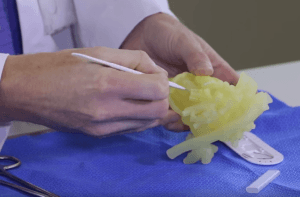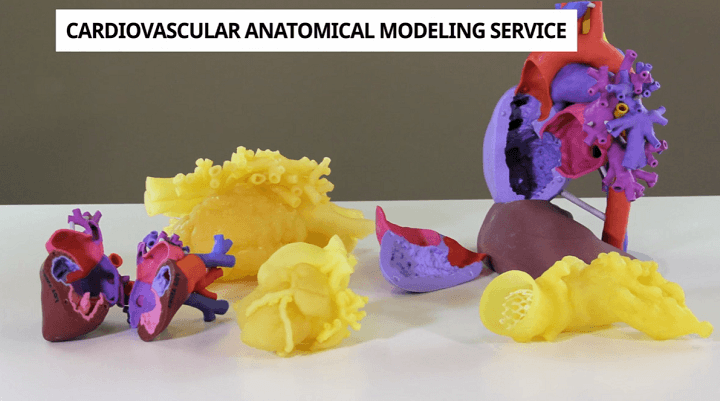 3D printed models are making their way more and more frequently into medical settings, as doctors and patients around the world continue to benefit from anatomically accurate models to explain, understand, and prepare for surgical procedures before a scalpel is anywhere near an actual patient. The unprecedented accuracy afforded by 3D technologies allows for a truly hands-on approach to surgical preparation, as doctors are able to truly understand the working dynamics of individual patients’ anatomies — which is especially critical for organs such as the heart.
3D printed models are making their way more and more frequently into medical settings, as doctors and patients around the world continue to benefit from anatomically accurate models to explain, understand, and prepare for surgical procedures before a scalpel is anywhere near an actual patient. The unprecedented accuracy afforded by 3D technologies allows for a truly hands-on approach to surgical preparation, as doctors are able to truly understand the working dynamics of individual patients’ anatomies — which is especially critical for organs such as the heart.
This week, 3D Systems announced a new extension of their offerings in medical 3D printing solutions. The company, which has been offering great focus on patient-specific offerings, is now expanding its anatomical modeling services through the new inclusion of pliable MultiJet Printing (MJP) material that is said to mimic patient physiology and allow for practice of procedures prior to the operating room.
https://youtu.be/3otLEpFFhkQ
Doctors, such as Shafkat Anwar, MD — Cardiology Director, Cardiac MRI Program, The Heart Center, St. Louis Children’s Hospital, Assistant Professor of Pediatrics, Division of Pediatric Cardiology, Washington University in St. Louis School of Medicine — are already touting the benefits of the expanded offerings, having worked forsome years with 3DS toward the creation of patient-specific planning models.
“Our cardiothoracic surgeons routinely use 3D printed models for precise pre-surgical planning, and have found these models helpful for complex cases. The models are also regularly used in our institution for trainee education and for counseling patients and their families. More recently, we have incorporated flexible 3D printed models into our pre-surgical ‘dataset’ and use both the flexible and rigid multicolor models for surgical planning. We have been consistently impressed by the high level of technical expertise of 3D Systems’ team, and the surgical models have proven accurate to the anatomy encountered in the operating room,” Dr. Anwar says.
 Doctors such as Dr. Anwar will now have the opportunity to create additional types of 3D printed heart models prior to surgeries. 3DS notes that its MJP material is well suited for pre-surgical planning and surgical rehearsal, as these materials mimic patient anatomy — and are 3D printed in one piece. Surgeons are thus able to interact with the heart models, designed exactly to match the patients’, to practice procedures, even cutting, suturing, and grafting the models as they will for the actual heart in the operating room.
Doctors such as Dr. Anwar will now have the opportunity to create additional types of 3D printed heart models prior to surgeries. 3DS notes that its MJP material is well suited for pre-surgical planning and surgical rehearsal, as these materials mimic patient anatomy — and are 3D printed in one piece. Surgeons are thus able to interact with the heart models, designed exactly to match the patients’, to practice procedures, even cutting, suturing, and grafting the models as they will for the actual heart in the operating room.
Additionally available from 3DS is their full-color ColorJet Printing (CJP) option for cardiac 3D modeling. These color models are educaitonal, as they can show both doctors and patients specific areas of each heart structure. The true-to-anatomy patient-specific models exactly illustrate what is happening in the patient’s heart, and the full-color aspect of it makes it easy during a consultation to describe problem areas that will be addressed surgically.
 All heart models are created using radiographic imaging data, ensuring exact measurements for these patient-specific structures. These 3D modeling and printing services are intended for planning purposes in cases where patients are afflicted with critical congenital heart defects (CHD), which the National Institutes of Health note affect approximately 12 out of 1,000 live births.
All heart models are created using radiographic imaging data, ensuring exact measurements for these patient-specific structures. These 3D modeling and printing services are intended for planning purposes in cases where patients are afflicted with critical congenital heart defects (CHD), which the National Institutes of Health note affect approximately 12 out of 1,000 live births.
3D Systems will be displaying their cardiovascular offerings this weekend at the American Heart Association Annual Meeting, which is held November 13-15 in New Orleans. For more information about 3DS’ healthcare offerings, see here. Discuss in the 3D Systems forum at 3DPB.com.
[Source/Images: 3D Systems]Subscribe to Our Email Newsletter
Stay up-to-date on all the latest news from the 3D printing industry and receive information and offers from third party vendors.
Print Services
Upload your 3D Models and get them printed quickly and efficiently.
You May Also Like
Making Space: Stratasys Global Director of Aerospace & Defense Conrad Smith Discusses the Space Supply Chain Council
Of all the many verticals that have been significant additive manufacturing (AM) adopters, few have been more deeply influenced by the incorporation of AM into their workflows than the space...
EOS in India: AM’s Rising Star
EOS is doubling down on India. With a growing base of aerospace startups, new government policies, and a massive engineering workforce, India is quickly becoming one of the most important...
PostProcess CEO on Why the “Dirty Little Secret” of 3D Printing Can’t Be Ignored Anymore
If you’ve ever peeked behind the scenes of a 3D printing lab, you might have caught a glimpse of the post-processing room; maybe it’s messy, maybe hidden behind a mysterious...
Stratasys & Automation Intelligence Open North American Tooling Center in Flint
Stratasys has opened the North American Stratasys Tooling Center (NASTC) in Flint, Michigan, together with automation integrator and software firm Automation Intelligence. Stratasys wants the new center to help reduce...



































